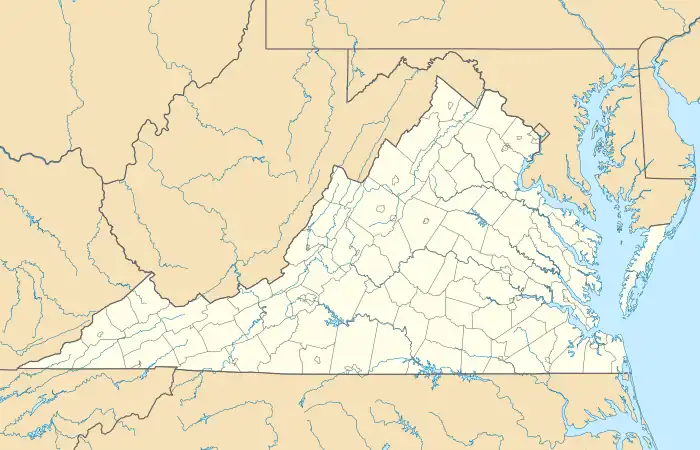Lone Oaks | |
 From Grandin Road | |
  | |
| Location | 3402 Grandin Road Extension SW, Roanoke, Virginia |
|---|---|
| Coordinates | 37°14′56″N 80°0′17″W / 37.24889°N 80.00472°W |
| Area | 2.9 acres (1.2 ha) |
| Built | 1852 |
| Built by | Deyerle, Benjamin |
| Architectural style | Classical Revival |
| NRHP reference No. | 73002054[1] |
| VLR No. | 128-0010 |
| Significant dates | |
| Added to NRHP | April 11, 1973 |
| Designated VLR | January 16, 1973[2] |
Lone Oaks, also known as the Benjamin Deyerle Place and Winsmere, is a Greek Revival mansion listed on both the National Register of Historic Places and the Virginia Landmarks Register in the Greater Deyerle neighborhood of the independent city of Roanoke, Virginia. Located at 3402 Grandin Road Extension SW, Lone Oaks was completed in 1850 as the private residence of Benjamin Deyerle overlooking Mudlick Creek.[3][4] Today the home still stands, with the surrounding area now developed as single family home typical of those built during the 1970s–1980s.[4] Today the home remains as a private residence.[5] The house is L-shaped with a single pediment Doric entrance portico, which has plain square pillars and fluted columns. It became a Virginia Historic Landmark and was listed on the National Register of Historic Places in 1973.
Main house
"A two-story, L-shaped brick house with three bay facade, rigid symmetry, parged antae and full entablature, Lone Oak is well within the form and style of the other houses Benjamin Deyerle erected during his most prolific period, between 1848 and 1851. Today, Lone Oaks retains its original, well proportioned Doric Portico with Pediment supported by paired groups of outside pillars and inside columns."[6]
Lone Oak is on a hill facing Mill Mountain and overlooking the Roanoke River, is a brick house of modern appearance. Its central block, with walls two feet thick, was built by the Tosh family, incorporating an earlier log house. It was known originally as 'Rock of Ages' from the rock ledge on which it stands, and was probably the first block house in this part of the valley.[7]
Outbuildings
Several 19th century outbuildings on the Lone Oaks property are interesting. They date from the construction of the main house or later. Many of the bricks used are rejects from the primary selection, and some are friable and partially deteriorated.
Springhouse
A two-story spring house and dwelling or office is built into the side of Mud Lick Creek where a spring keeps the basement cool. The limestone foundation and brick walls has an entrance to the dwelling area from the uphill side, and has a large fireplace and chimney.
Slave quarters
The slave quarters, barracoon, office and dwelling has two over two rooms, and is made from brick with 13" walls. All the rooms are heated by fireplaces. The south room on the first floor has a large fireplace and may have been used as an outdoor kitchen for the house.
Smokehouse
The Smokehouse is a two-story, front gabled brick structure. Many of the bricks used in the construction are durable, but were probably rejected as being too imperfect to be used on the walls of the main house.
Privy
The privy is a curious construction, for a long mis-identified as a brick kiln. Because it had a flue ventilated chimney, it was mistakenly viewed as a fireplace for heating the bricks. However, there is no fireplace at all, and was used only for ventilation.[6]
References
- ↑ "National Register Information System". National Register of Historic Places. National Park Service. July 9, 2010.
- ↑ "Virginia Landmarks Register". Virginia Department of Historic Resources. Retrieved 19 March 2013.
- ↑ Virginia Historic Landmarks Commission Staff (September 1975). "National Register of Historic Places nomination, Lone Oaks (Benjamin Deyerle Place)" (PDF). Retrieved 2008-09-06.
- 1 2 "Greater Deyerle Neighborhood Plan: History" (PDF). City of Roanoke Planning Division. Archived from the original (PDF) on 2011-07-21. Retrieved 2008-09-06.
- ↑ "City of Roanoke GIS". City of Roanoke. Archived from the original on 2011-07-21. Retrieved 2008-09-06.
- 1 2 Pulice, Michael J. 2011. Nineteenth-Century Brick Architecture in the Roanoke Valley and Beyond: Discovering the True Legacies of the Deyerle Builders. Roanoke, Va: Historical Society of Western Virginia, 2011. Pages 68-73.
- ↑ Writers' Program (Va.). Virginia: A Guide to the Old Dominion. New York: Oxf. Univ. Press, 1947. "Points of Interest". Page 303.

